Reading Vaginal Smears to Determine When to Breed Your Bitch
"Becoming a dog breeder means having the courage to stick with the dogs of your bloodline (because they work) and not getting sidetracked into popular fads, and yet still having the common sense to admit when you made a mistake in selecting breeding partners." -Ed Frawley
Being able to perform and read vaginal smears at your kennel is going to greatly improve your success rate in getting bitches bred. The vaginal smear is not perfect but it’s sure better than guessing what day a bitch should be bred on.
In recent years, we have seen a lot of publicity on progesterone testing of a bitch’s blood to determine the exact day to breed. Some of these tests (I will not name names) are useless and a total waste of money. Others are expensive and require blood to be sent in to a lab to test. This may take days and can be time prohibitive. The concept is good but until our local vets can perform tests in their office and give us on-the-spot test results, they are not that functional for the average dog breeder.
Outside of a good old stud dog, the best method available to determine when to breed a bitch remains the vaginal smear.
Many breeders don't use it because they believe it's difficult and don't understand how simple it is to read. This article is meant to help correct this situation.
A number of years ago, my vet (Dr. John Flynn in Eau Claire, WI) gave me a chart put out by the Ralston Purina Company. I doubt that Purina still offers it. I tried to get another and could not. This chart showed pictures of vaginal smear slides from different times during a bitch's cycle. It was extremely helpful teaching me how to interpret an individual slide. The photos in this article are from that Purina publication.
In medical terms, a bitch goes through 4 different stages:
- Proestrus
- Estrus
- Metestrus
- Anestrus
Proestrus begins when the bitch swells and begins to drop blood. It typically can last from 4 to 20 days. During this period a bitch may attract males but will not accept them for breeding.
Estrus is the time a bitch can be bred. This can last from 4 to 13 days. Typically, this is the 9th to the 12th day of a bitch's season. But I have seen bitches bred as late as the 26th day of season. Determining estrus is critical in determining when to breed (either naturally or with artificial insemination).
Metestrus is the period after estrus and can last 80 to 90 days. During this period, the bitch will not accept a male.
This period represents the quiet phase of the bitch's estrus cycle. It lasts 2 to 3 months after metestrus. During this time period, the female is not swollen and will not allow breeding.
Doing vaginal smears requires a good microscope. We bought our scope used from a local vet.
Proestrus
Determining the first day of a bitch's season (that point where she starts to bleed) is important. If you have not bred a bitch before, it’s good to know that most bitches will blow their coat just before coming into season. This can be anywhere from 3 weeks before she begins to bleed to the week of proestrus. I try and educate the foster parents of my bitches to watch for this sign. When they begin to see the bitches shedding, it’s time to do a visual inspection each morning before the dogs go outside.
The problem is that many females will clean themselves by licking for several days before the blood is actually noticed.
It's a good idea to establish a baseline of slides during proestrus. By starting on the 5th or 6th day and then doing smears every day or every other day, you will be able to notice significant changes in the cell structures.
When I try and explain what to look for to new employees, I tell them that during proestrus, the slide has little dark dots and fried eggs. The dark dots are red blood cells. The fried eggs are the epithelial cells. During proestrus, there are a lot of red blood cells and the epithelial cells are nice and round with dark round centers. (See the photo below.)
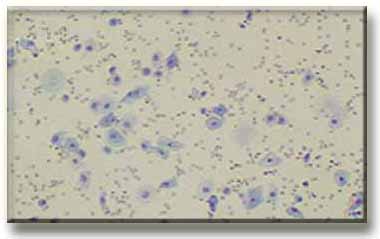
What we want to watch is the changes in the epithelial cells. As a bitch moves through proestrus, there will be a reduced number of red blood cells and the epithelial cells will begin to look like potato chips. The centers will disappear and the edges of the cells will begin to get rough (the vets call these cells cornified epithelial cells). This is when the bitch is approaching estrus. When I notice this change, I will do daily slides.
During the early days of proestrus, the female will initially not allow the male to mount her, but as she nears the end, she will flag and allow the male to mount but she will not allow penetration. When I see this, I know I am within a day or so of breeding the female.
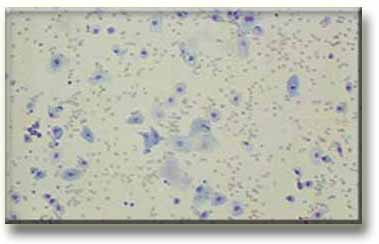
Estrus
Estrus normally occurs 8 to 11 days after a bitch starts to discharge. It lasts 4 to 13 days and during this time, the female can be bred. A visual exam will indicate swelling of the vagina area and noticeably less blood in the discharge.
When the slides are examined, there is a noticeable difference between proestrus and estrus. During estrus, there are very few (if any) red blood cells (erythrocytes). There will be a dramatic increase in the cornified epithelial cells. They will often be stuck together in chunks (but this can vary because of the way that you manually roll the cells onto the slide.) You can see what this looks like in the photo below.
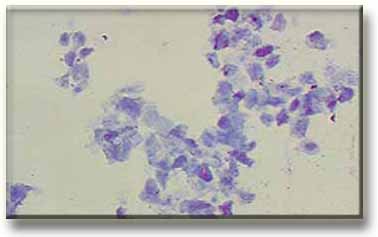
On normal bitches, this is the time to start to breed naturally or do an A.I. (artificial insemination). How often and when to breed is something I have found to be controversial among vets. I have been told (by well-respected vets who specialize in breeding dogs) that if I own the stud dog, I should breed her every day that she will stand. On the other hand, there is a lot of published information that indicated breeding 2 times 2 days apart is all that is necessary.
What I will do is collect a male and examine his sperm. If the male is young, healthy, and full of sperm, breeding one or two times is all that's necessary (on a natural breeding, sperm can live 4 days in the bitch - less of A.I.'s). As the stud ages and there is noticeably less sperm, it may be a better idea to breed more often. I will also collect a male several days in a row and watch how this affects the dog’s sperm production. If a dog can continue to produce enough healthy sperm, you will know if he is capable of breeding 2 females on alternate days. When you collect sperm, it’s a good idea to warm the slide to body temperature (101 degrees) before depositing the sperm to be examined. You will have a better idea of the mobility of the sperm that way rather than put them on a cold slide.
Collecting males is a subject of its own article.
Metestrus
During this period, the bitch will quit flagging and will not breed anymore. There is a noticeable lack of interest in being friendly to males. This period represents the "leuteral" or regressive stage of a bitch's season.
Once again, this period lasts 80 to 90 days. During the first 2 or 3 days, there is a noticeable lack of cornified epithelial cells. During the first 3 or 4 weeks, there is an increased number of leukocytes. As this period progresses, you will begin to see non-cornified epithelial cells again (the fried eggs).
Anestrus
This period lasts 2 or 3 months and during this time, there are very few cells noticeable if a slide is taken. The photo below is an example of what you would typically see.
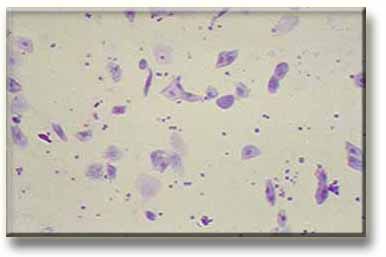
Determining If the Bitch is Pregnant
Once you have bred the bitch, it is very helpful to know if the breeding took. Until recently, (at least in my area), this has been difficult. If a female is a large bitch with a small (one or 2 babies) litter, the breeder would often not know she was pregnant until the puppies arrived.
A vet in my area recently started using a blood test called "Fibrinogen Assay". If blood is drawn on a female before a breeding, and then 30 days after the breeding. The vet can tell you if the bitch is pregnant. I am told that is 100% accurate.
I am told that a "Fibrinogen Assay" can even be used if blood is not drawn before the bitch is bred. When this happens the degree of accuracy goes down a little.





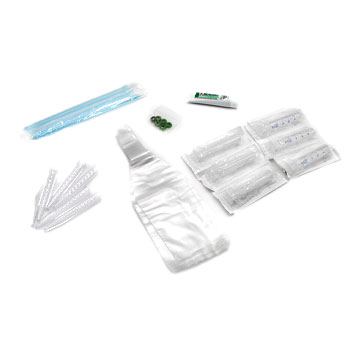



Ask Cindy.